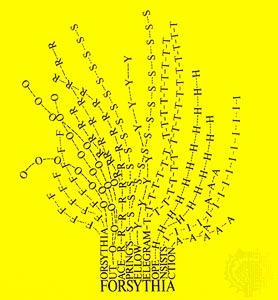concrete poetry
art
 poetry in which the poet's intent is conveyed by graphic patterns of letters, words, or symbols rather than by the meaning of words in conventional arrangement. The writer of concrete poetry uses typeface and other typographical elements (typography) in such a way that chosen units—letter fragments, punctuation marks, graphemes (letters), morphemes (any meaningful linguistic unit), syllables, or words (usually used in a graphic rather than denotative sense)—and graphic spaces form an evocative picture.
poetry in which the poet's intent is conveyed by graphic patterns of letters, words, or symbols rather than by the meaning of words in conventional arrangement. The writer of concrete poetry uses typeface and other typographical elements (typography) in such a way that chosen units—letter fragments, punctuation marks, graphemes (letters), morphemes (any meaningful linguistic unit), syllables, or words (usually used in a graphic rather than denotative sense)—and graphic spaces form an evocative picture.The origins of concrete poetry are roughly contemporary with those of musique concrète, an experimental technique of musical composition. Max Bill (Bill, Max) and Eugen Gomringer were among the early practitioners of concrete poetry. The Vienna Group of Hans Carl Artmann, Gerhard Rühm, and Konrad Bayer also promoted concrete poetry, as did Ernst Jandl and Friederike Mayröcker. The movement drew inspiration from Dada, Surrealism, and other nonrational 20th-century movements. Concrete poetry has an extreme visual bias and in this way is usually distinguished from pattern poetry. It attempts to move away from a purely verbal concept of verse toward what its proponents call “verbivocovisual expression,” incorporating geometric and graphic elements into the poetic act or process. It often cannot be read aloud to any effect, and its essence lies in its appearance on the page, not in the words or typographic units that form it. At the turn of the 20th century, concrete poetry continued to be produced in many countries. Notable contemporary concrete poets include the brothers Haroldo de Campos and Augusto de Campos (Campos, Haroldo de; and Campos, Augusto de). Many contemporary examples of animated concrete poetry can be found on the Internet.
- Daniel Coit Gilman
- Daniel Cowan Jackling
- Daniel C. Tsui
- Daniel Day-Lewis
- Daniel Decatur Emmett
- Daniel Defoe
- Daniel De Leon
- Daniel Drew
- Daniel D. Tompkins
- Daniel Dulany
- Daniele Crespi
- Daniele da Volterra
- Daniel Edgar Sickles
- Daniele Manin
- Daniel Ernst Jablonski
- Daniel F Malan
- Daniel-François-Esprit Auber
- Daniel François Malherbe
- Daniel, Gabriel
- Daniel Gabriel Fahrenheit
- Daniel Gray Quillen
- Daniel Gregory Mason
- Daniel Greysolon DuLhut, Sieur
- Daniel Greysolon, Sieur DuLhut
- Daniel Guggenheim